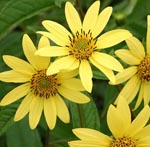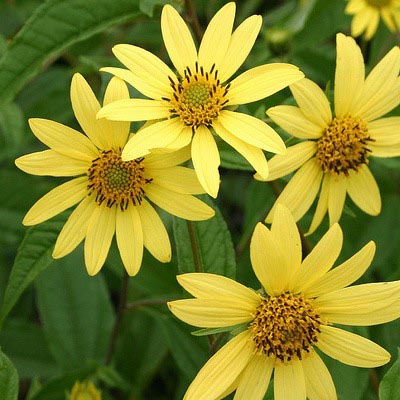Use more yellow in your garden
Yellow colours look beautiful in autumn light, and draw the eye wonderfully well in a planting scheme for your garden all year round, says Tom Coward


** If you want to buy any of the plants mentioned below for your own garden, visit www.countrylife.co.uk/nursery and type or copy and paste the name into the search. Plants are delivered in sturdy boxes in a matter of days from one of the finest nurseries in the country. **
I have often seen people dismiss the colour yellow from the garden, declaring it harsh and jarring and difficult to combine in a planting scheme tastefully. But, when sensitively placed with complementary companions, it can be used to draw the eye along the garden, highlighting spots through the border. In the mellow autumn light, strong yellows shine out, lifting the garden and the spirits before the inevitable arrival of winter and its very limited colour palette.
If you're a gardener of the anti-yellow persuasion, I urge you to take another look at some of the large yellow daisies, many of which are still flowering well in the borders here, despite the recent grim weather, and can also be naturalised into the wild garden. They can always be relied on to deliver invaluable long-seasoned interest through the end of the summer and deep into the autumn, and are really charming when used sensitively.
Take the 8ft tall Rudbeckia laciniata Herbstsonne (autumn sun), with flowers held aloft on stems 6ft-8ft tall. At Gravetye, we've had it flowering since early August beside the calming influence of blue-green leaved Salix purpurea Nancy Saunders and the white flowers of Erigeron annuus. The vertical accent and bright colour of the rudbeckia contrasts with the softer textures and colours nearby; it works like a beacon, illuminating the border on the dullest of autumn days yet is refined by its neighbours.
A cooler autumn yellow is achieved with Helianthus Lemon Queen, one of the toughest and most vigorous of perennial sunflowers, delivering a mass of lemon-hued blooms from August until the frosts. In the border, it needs no staking at all, despite growing to about 6ft, and will bulk up to form big clumps very quickly. Divide the rootstocks in autumn to make new plants.

Lemon Queen also performs well in long grass, adding some late-season interest to the meadow, where its pale yellow lifts the browns of the grasses at this time of year. I've been growing on some plants in the vegetable garden for exactly this purpose, which I'll move in a few weeks' time to be planted in 3ft-square planting pits, where the turf has been removed and the soil enriched with horse manure. With such attention at the start, they should naturalise quickly and continue to flower for many years to come, only bothering the gardeners when they need to be cut down, along with the late cut of the grass, at autumn's end.
Lemon Queen had long been a favourite of mine until I discovered Helianthus Carine it's similar, but a shade more subtle in its flowers, which are held on dark stems. I've yet to see if it will perform as well as Lemon Queen in the meadow, but Carine excels as a border plant. After giving it a trial in the vegetable garden, I'm going to divide its rootstock this autumn to plant in our newly refurbished long border. I hope it will shine among its neighbours, beautiful blue Aster thomsonii, Miscanthus sinensis Malepartus and Persicaria amplexicaulis Firetail.
Sign up for the Country Life Newsletter
Exquisite houses, the beauty of Nature, and how to get the most from your life, straight to your inbox.
Telekia speciosa is another tough yellow daisy, self-sowing freely here in a rather shady shrub border. But, after seeing it in a friend's meadow in Holland, I'm thinking of using it as a linking plant between the new long border and our adjacent wildflower meadow. It flowers through July and August, and the seedheads are beautiful in winter. Although its appearance is much like the monstrous Inula magnifica, the Telekia is a little more refined, growing to about 4ft. I sowed its seeds last autumn and, after over-wintering in the cold frame, they've grown into big plants, now ready to get growing in the open ground.
* Subscribe to Country Life and get the Ipad edition at no extra cost
* Follow Country Life Magazine on Twitter
Country Life is unlike any other magazine: the only glossy weekly on the newsstand and the only magazine that has been guest-edited by HRH The King not once, but twice. It is a celebration of modern rural life and all its diverse joys and pleasures — that was first published in Queen Victoria's Diamond Jubilee year. Our eclectic mixture of witty and informative content — from the most up-to-date property news and commentary and a coveted glimpse inside some of the UK's best houses and gardens, to gardening, the arts and interior design, written by experts in their field — still cannot be found in print or online, anywhere else.
-
 380 acres and 90 bedrooms on the £25m private island being sold by one of Britain's top music producers
380 acres and 90 bedrooms on the £25m private island being sold by one of Britain's top music producersStormzy, Rihanna and the Rolling Stones are just a part of the story at Osea Island, a dot on the map in the seas off Essex.
By Lotte Brundle
-
 'A delicious chance to step back in time and bask in the best of Britain': An insider's guide to The Season
'A delicious chance to step back in time and bask in the best of Britain': An insider's guide to The SeasonHere's how to navigate this summer's top events in style, from those who know best.
By Madeleine Silver